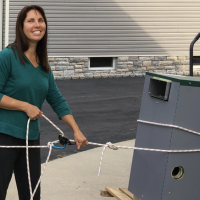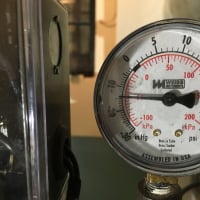(Updated with pictures.) Likely gas leak after installing new thermocouple?
Hope I chose the right category.
Hi, I apologize in advance if this has been discussed already. (You're also probably going to need to talk to me like I'm five years old as I have no experience with boilers.) I'm willing to upload photos and provide information so long as it can be clearly explained how to find it.
Burnham Steam boiler. Left heat on for a couple of weeks while away in December because it was getting colder and unsure. (Turned out to be not so bad; could have saved money on bills.) Wouldn't start up a couple of weeks ago though after it got colder. Went down to the furnace and had trouble keeping the pilot lit. I did get a permanent flame once but it went out after I switched the thermostat on. Every time after this the flame simply would not stay lit after I let go of the pilot button on the furnace. In both cases it was a small blue flame.
Decided to replace the thermocouple and immediately got a large yellow flame. Though about 30 seconds into holding the pilot button down another flame erupted from under where the thermocouple screws in, engulfing the line some. It stayed this way after I let go, and until I dialed the pilot to off.
The majority of heating repair businesses in my town won't even touch boilers they themselves haven't installed. I'm nearly broke and after explaining the above to one over the phone they told me I could need an entire new gas valve somewhere around $700. The same White Rodgers model I have goes for a little over $100 online, so I'm unsure how well to trust the business I spoke to (All Seasons Heating & Cooling).
Given where the second flame was coming from, is it possible there is just an issue under the thermocouple or possibly the line right next to it? Can anything be done to determine this? We're in arctic temperatures right now and last night was pretty rough. Any help would be appreciated. Thanks.
Edit:
^ Original assembly / prior to exchanging thermocouple.
^ Quick photo of aforementioned flame before killing gas. This is after exchanging thermocouple.
^ Clip loose pulling assembly back out.
^ As tight as I could get it.
Comments
-
-
-
The same White Rodgers model I have goes for a little over $100 online, so I'm unsure how well to trust the business I spoke to (All Seasons Heating & Cooling).
These HVAC companies make NO MONEY changing a thermocouple……….or the supply line to it. You've got $60 in parts. If they charge you $150 they are losing money. The can't charge you $300 which is what it costs them in time.
So, anytime anything near the pilot goes bad…………….."you need a gas valve". So $800 later, with tax, they make some money on it.
That's how it works.
2 -
-
Who changed the thermocouple? If this was a DIY replacement, then the person that did the replacement is not qualified to work on a gas fire that is inside your home. A basic understanding of how houses can burn down from a out of control gas flame is needed before you can safely work on any gas piping, tubing or controls.
If you feel that you can do a better job than the guy that incorrectly replaced the thermocouple, then you will need some parts to replace the aluminum tube that runs from the gas valve to the pilot burner. This Pilot tube kit is easier to work with than the 1/4" ones. You will want to check the pilot burner while you have it out of the boiler. if the pilot orifice is partially plugged then you will need to replace that also. I will need to see a picture of the pilot burner to recommend a replacement pilot orifice or complete pilot burner replacement. But many times all that is needed is to clean the pilot burner by soaking it in alcohol or brake cleaner and blowing it completely dry before reinstalling the pilot tube tightly. If it is loose then the gas will leak out where it is not supposed to and may cause a fire to happen where you don't want a fire to happen.
After you have the thermocouple and pilot tube attached to the pilot burner you can put the pilot burner back in place on the boiler’s main burner. Once the pilot burner is properly installed on the main burner you then take the other end of the ⅛” pilot tube and connect it to the gas valve pilot port, and the other end of the thermocouple to the thermocouple port of the gas valve.
I hope this helps get your pilot and thermocouple back in order
EDIT: Extra fittings come in long, standard and short from ResideoEdward Young Retired
After you make that expensive repair and you still have the same problem, What will you check next?
5 -
I know you're broke, but a natural gas leak is VERY serious business. You could go in a much deeper hole financially & cause yourself and occupants bodily harm. If you can't figure this out quickly, time for a licensed Pro to step in. Keep us apprised please. Mad Dog
..
0 -
Are you suggesting I have someone come over and refuse to pay them after?
0 -
what???? Why would you not pay ???
Slant Fin Galaxy GG100(1986) , 2 zone hot water baseboard, T87 Honeywell thermostats.0 -
Of course not, just level with them. I've worked with plenty of people over the years if they leveled with me. Would you do surgery on yourself because you couldn't afford an MD?
You've already crossed in to iffy territory now that you're sniffing gas. Mad Dog
0 -
Hi @Lashen , Can you post some photos of what you have? It might be something we can talk you through, depending on what's there.
Yours, Larry
0 -
All payments are expected at the time of service from businesses in my area, which is unfortunately money I don't immediately have. We're talking flat broke and no gas in my vehicle. Worst time for all this to happen; I'm going to have to begin the habit of testing this furnace sooner rather than later each year.
I would rather do surgery on myself given the medical insurance situation we have in the States. (Lost my whole family to it in the span of two years.) I've spoken with every business in town and the ones that even want to work on my boiler demand payment at the time of service. I mentioned explaining my situation over the phone, and to clarify, in doing so said I only had about enough money to cover the first hour and nothing more (replacements or whatever else). I don't know how much more I can level with someone. Sniffing gas? The least you could do is read my post, or maybe ask if I shut off the gas valve (I have along with power to the furnace; no smell). You're a consultant? I appreciate the concern, but I think you're more eager to reply for some reason than confirm your skimmed assumptions about my problem or generosity of the businesses available to me. I don't believe this helps. (Many people in here have been really insightful though.)
Absolutely! I do already have some photos, but I'll take some more and get back soon. :)
0 -
I absolutely read your post, that's why I'm concerned you may be in over your head. Natural gas and propane leaks (all fuel for that matter) can be deadly. It's very hard to walk you through something remotely with any assurance that youll have done it safely in the end.
As a Licensed Master Plumber, I have a legal & moral obligation to treat possible Life Safety issues with extreme prejudice. I cannot & will not assist anyone, remotely, on fuel gas related issues.
If you were making a repair on a waste line or steam.pipe or wet return (not life threatening possibilities), I'm happy to and often weigh in with my advice. Gas leaks can be very elusive and hard to pin down.
As a consultant, how would I have anything to gain from you? I have no idea where you are located and doubt I cover your area for gas/no heat service.
Just be careful. I'd rather your home be cold than worse things happen. Mad Dog
4 -
Updated original post with photos.
0 -
That sure doesn't look like 1/4" tubing going in to the pilot assembly!
0 -
Tubing appears to be the same size as the old one?
0 -
Looks like the nut is loose and it is leaking at the connection to the pilot burner too. either that or the orifice is loose.
0 -
This was the replacement used.
0 -
Hi @Lashen , I agree with what @mattmia2 said. If you look closely, there is some whitish buildup between the nut and what I'll call the body that the gas tubing is attached to. It suggests a leak. If you have some skill and tools, you could do this, or get a handy-person, but I'd back that nut out and then clean things up. Then reinstall the nut using two wrenches, one on the nut and the other on the body. Also, the aluminum pilot tube usually would be coming straight out of the bottom, not as angled as it is. Finally, the tubing looks like 1/8" tube, not 1/4" tube, but the fitting looks like it would fit 1/4". I'd want to look at that a little closer to see if the tubing really fits correctly and if it might have been changed.
This is gas and it's dangerous. I'm talking to you like I'd talk with a technician. If any of this is not in your wheelhouse, please do get help.
Yours, Larry
3 -
Believe me, doing this myself was not my first option, and neither was making an account to come here and ask about it. I have under $100 to my name for a while and don't know anyone who can help personally. Every service in my area wants to collect payment at the time of service and one hour of time by itself is $90-95. I can double check, but the whitish buildup is likely ash, as I banged something in there and stirred up some moving the pipes aside to pull the assembly out again for photos.
0 -
The copper colored length is the thermocouple, it is not the issue causing the gas leak or yellow flame.
The silver/aluminum tubing is the issue. It is likely compromised in some way, be it a split, crack or otherwise poor fitment. The tubing is generally 1/4” diameter. This needs to be replaced at a minimum. There is also an orifice that needs to be there as well.Where are you located? Surely someone can get this fixed in a safe and affordable manner.
Slant Fin Galaxy GG100(1986) , 2 zone hot water baseboard, T87 Honeywell thermostats.0 -
-
As I removed my old thermocouple and installed my new one, the silver / aluminum line next to the thermocouple's rotated easily underneath at the nut/bolt it feeds into. It turns 360 degrees with no resistance.
0 -
Hi @Lashen , I looked again and don't believe the whitish buildup is ash. It's in too many places where ash wouldn't stick. I've seen this sort of thing caused by gas leaks in the fifty plus years that I've been working on equipment. Are you good with your hands? If so, you'll want two open end wrenches, one for the nut and one for the body. Maybe even something like a 4" crescent wrench could be used, but you want an open end type with the close quarters around the pilot assembly. That's probably all you need to fix this.
I'll add that utility companies vary in how they might respond to a call for help. In my area, they are so concerned about liability that they will turn off your gas even when it's cold in winter, rather than fix a simple problem. Maybe your utility has a bigger heart. Without giving them any of your info, is it possible for you to call them and see what their policy is? Just maybe they'll fix it at no charge 🤔
Yours, Larry
1 -
Well, based on how I had to turn the assembly to pull it out and the ash that dumped down it's still possibly ash, but I'll see what it is in the morning. I can't call the utility company by then anyhow. I'm assuming you believe this is some kind of corrosive buildup that's easily distinguishable from ash powder. Should be an easy confirmation even for me.
0 -
-
Then it's loose and likely the wrong size as well. A properly tightened compression fitting would hold the tube rigidly.
I understand the pros reticence about giving remote instructions that can get you blown up, but it really is a 15 minute job for the reasonably handy.
Oh, and the white stuff is not ash.
Trying to squeeze the best out of a Weil-McLain JB-5 running a 1912 1 pipe system.2 -
Okay, just to confirm with you. I'm talking about the line on the left here (not thermocouple) rotating freely where it meets the nut there, not at the top. This is what you mean?
0 -
-
So, my local gas company offers repair service at a yearly charge for heating appliances that are already confirmed to be in working order. Later, speaking with our most reputable contractor, a new pilot assembly minus hours, etc. runs me $$$ (internet for all makes and models seems to be around $$), and a new gas valve $$$ (going rate for my exact model is $$). I'm sorry to say, but unless I missed something I feel surrounded by crooks in my area. I understand the nature of the beast, but when you're freezing to death and met with indifference it's a bit much. I'd love to be wrong.
0 -
You need a pilot tube and a compression nut. The parts are cheaper than lunch. Often there's sufficient tubing to cut off the cracked part and use the rest, so you may not even need that. Or maybe the nut's just loose. The nut would be cheaper than a cup of coffee.
Many contractors offer high-interest-rate EZ Financing for customers with no money. Find one who does. Or barter, or sell something, like the house.
Asking for charity is an art that some find difficult to learn. Make phone calls and ask nicely. Insulting skilled tradesmen and calling them crooks is usually an ineffective approach.
2 -
If it costs too much to pay someone else to do it, you can always do it yourself.
0 -
Hi @Lashen , It really boils down to whether or not you have some confidence with tools. If you (or a friend) does, we can talk you through what needs doing. I'm glad to help you out over the phone if you want to PM me. Freezing isn't much fun 😰
Yours, Larry
0 -
The tubing needs to be disconnected from the gas valve. With the tubing loose gas will leak. The tubing should not be able to be moved when tightened.
What I suggest is turning the nut counter clockwise. The tubing should be 1/4" outside diameter (I have never seen one a different size) and remove the tubing. The tubing needs to go in the valve straight and square with no bend or kinking at the nut. Then tighten it up snugly with a new compression fitting.
As others mentioned if the tubing is long enough you can cut the bad end off.
Hope this helps.
0 -
according to the first photo attached at the beginning of the thread. There looks like plenty of slack on the tubing to reshape it under the pilot assembly to soften that bend. Here’s a nice video clip I found that shows what many are explaining about the loose nut under the pilot light. If you’re not comfortable maybe a neighbor can help with the video assist.
3 -
-
-
I'm not an expert, but I agree with what everyone is saying here. I have one thought.
Your local hardware store likely sells some "Gas Leak Detection Liquid". It is typically vibrantly colored and is somewhat thick like liquid dish soap. It is very cheap, probably less than $10 and some versions come with a cotton swap tip to allow you to brush it onto gas lines.
This may help you identify where exactly the leak is coming from or if there is a split in the gas line to the thermocouple. It will create bubbles if gas is leaking. It tends to be messy so you'll want to wipe it off when you are done.
Lastly, as others have asked…where are you located? We don't need your address but what state or perhaps city are you closest too? I understand you want your privacy but for all you know one of the experts lives the next town over and would be willing to take a look in exchange for a case of beer or something. Maybe if your lucky it will only take a trained hand to tighten and adjust a few things.
1 -
-
Categories
- All Categories
- 87.3K THE MAIN WALL
- 3.2K A-C, Heat Pumps & Refrigeration
- 61 Biomass
- 428 Carbon Monoxide Awareness
- 120 Chimneys & Flues
- 2.1K Domestic Hot Water
- 5.8K Gas Heating
- 114 Geothermal
- 166 Indoor-Air Quality
- 3.7K Oil Heating
- 77 Pipe Deterioration
- 1K Plumbing
- 6.5K Radiant Heating
- 395 Solar
- 15.7K Strictly Steam
- 3.4K Thermostats and Controls
- 56 Water Quality
- 51 Industry Classes
- 50 Job Opportunities
- 18 Recall Announcements























